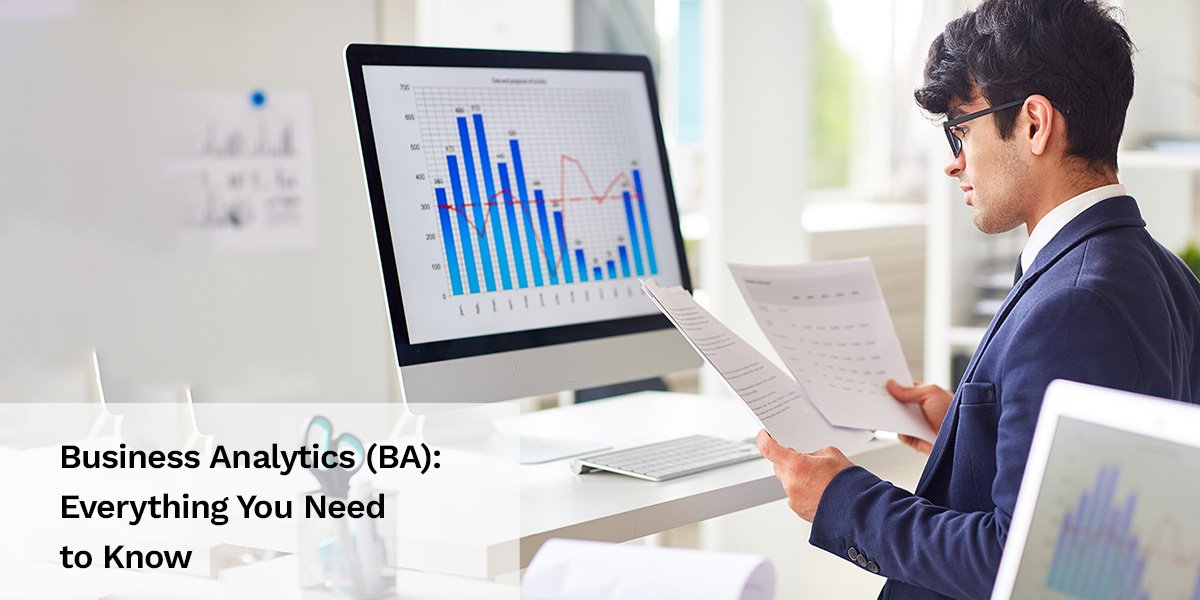- Sakal India Foundation
- January 10, 2022
Table of Contents
Business Analytics: Overview
Business analytics is a study of disciplines and technologies for solving business problems using data through statistical analysis, statistical models and other quantitative methods.
It adopts quantitative methods and the evidence required for data to build specific models for businesses and make profitable decisions.
The foundation of any successful business — from startups to established big players — is the ability to give customers what they want. And guesswork isn’t enough to figure out what that is.
That’s why Business Analytics is such a crucial field. It enables companies to know their customers’ wants and needs.
In this article, we have covered all the major pointers like how BA works, its components, types, tools, importance, applications, career scope and many more.
Business Analytics: How Does it Work?
Business Analytics (BA) is the process through which information is scrutinized after examining past performances and issues to devise a successful strategy for the future. Large amounts of data are used to derive solutions. This data-driven methodology towards building and sustaining a business is vital to the economy and industries that thrive in the economy.
Before data analysis, Business Analytics starts with several foundational processes:
- Determine the business goal of the analysis.
- Select an analysis methodology.
- Get the right business data to support the analysis from various sources.
- Filter and integrate data into a single repository, such as a data warehouse or data mart.
Business Analytics: Components
Business Analytics is generally classified into two main components: Business Intelligence (BI) and Statistical Analysis.
- Business Intelligence: Many organizations use Business Intelligence for reporting, dashboards, visualizations, and online analytical processing of historical data analysis. It typically details the different data trends that users can slice and dice as they see fit over some time, such as the past week, month, or quarter. BI usually involves descriptive analytics and decision analytics.
- Statistical Analysis: It is usually based on prescriptive and predictive analytics. Statistical Analytics involves sophisticated, math-based statistical procedures to determine trends and relevant signals in data. These complex calculations help organizations determine future data trends based on current and historical data.
Business Analytics: Types
Today, you will not find a business that doesn’t use analytics in some shape or form to inform business decisions and measure performance.
So, what methods of Data Analysis are used by businesses to generate desired results?
Different types of Business Analytics used by businesses include the following:
- Descriptive Analytics: It tracks key performance indicators (KPIs) to understand the present state of a business.
- Predictive Analytics: It analyzes trend data to assess the likelihood of future outcomes.
- Prescriptive Analytics: It uses past performance to generate recommendations for handling similar situations in the future.
Business Analytics: Tools
The tools used by Business Analysts comprise a variety of application that captures quantitative & qualitative data from various business systems and incorporate it into a depository.
Today’s state-of-the-art analytical tools packed with powerful features for business facilitate efficient data collection, analysis, and presentation in real-time, empowering enterprises to identify trends/patterns in vast datasets and create new business analytics models.
Here are the top 10 list of Business Analytics tools that we will discuss in detail:
- SAS Business Analytics: The SAS-based BA software allows users to inspect and transform unorganized text data into relevant information that analysts can explore to discover meaningful insights.
- QlikView: It is the most popular tool for Business Analytics because of its distinctive features, like Patented Technology and In-Memory Processing, enabling the delivery of fast BA reports.
- Board: Board features are on the list of top-rated business analyst software tools because of its industry-leading BA model that permits users to create interactive and intuitive BA reports and dashboards.
- Splunk: It is one of the most widely used Business Analytics tools in small and medium scale industries. It was launched for processing machine log file data, Splunk has added many features over the years, including a user-friendly interface and different visualization options.
- Sisense: This prevalent business analyst software tool incorporate dynamic and robust text analysis functionalities that enable analysts to transform unstructured text into valuable business intelligence.
- Microstrategy: The Microstrategy BA software integrates exceptional analytics capabilities that allow hassle-free processing of unstructured text data, which specialists can further analyze via the platform’s text analytics solutions. The software has statistical capabilities that enable real-time trend forecasting, with options for third-party data mining.
- KNIME: It is one of the best BA software for business analysts. Its unique data-pipelining approach, facilitates various components for machine learning and data mining that support persistent analysis, visual programming, and seamless business analytics report.
- Dundas BI: It offers robust BA tools that provide automated analytics, trend forecasting, and an advanced dashboard that helps analysts visualize data and create business analytics reports through easy-to-use drag-and-drop features.
- TIBCO Spotfire: This advanced tool for business analytics offers powerful and automated analytics solutions that allow data professionals to run BA reports and analyses over a defined period.
- Tableau Big Data Analytics: This BA platform has robust and reliable statistical tools, empowers analysts to perform an in-depth analysis of social media platforms, and predict patterns based on current and historical data.
Importance of Business Analytics
Business Analytics can help organisations make better, more informed decisions and achieve a variety of goals. By leveraging big data, businesses can:
- Good understand consumer behaviour
- Gain insight into their competitors
- Determine market trends
- Measure achievements against goals
- Optimize operations
Business Analytics: Uses & Application
Many organisations are adopting Business Analytics (BA) to facilitate data-driven decisions. The data insight acquired with the help of BA helps organisations optimize their varied techniques to provide even better results and a competitive advantage over others.
Uses of Business Analytics:
- To carry out data mining and explore new data to find new patterns and relationships.
- To carry out statistical and quantitative analysis to provide explanations for specific occurrences.
- Test previous decisions with the help of A/B testing and multivariate testing.
- Deploy predictive modelling to predict future outcomes.
Future Scope of Business Analytics
Business Analytics has a wide variety of uses and implementations. It can be used for descriptive research to explain the situation in the past and present. This kind of descriptive research is used to determine the company’s current market position and previous business decision effectiveness. Business Analytics is also used for predictive analysis, and companies will continue to use it to analyze their previous performance. For prescriptive analysis, business analytics is often used, which is used to formulate optimization strategies for better company results.
Today, the world is a smaller place these days, and for this, major credit goes to the Internet of Things (IoT) which will continue to grow rapidly.
Business Analytics tools and techniques for dealing with the enormous amounts of structured and unstructured data generated by IoT will continue to gain prominence in the corporate world.
Business Analytics Vs. Business Intelligence
Business Analytics and Business Intelligence are oftentimes used interchangeably. However, there are key differences.
Companies usually start with Business Intelligence before implementing Business Analytics.
Business Intelligence analyzes business operations to determine what practices have worked and where room for improvement lies. Business Intelligence uses descriptive analytics.
In contrast, Business Analytics concentrates on predictive analytics, generating actionable insights for decision-makers. Instead of summarizing past data pointers, Business Analytics aims to predict trends.
The data collected using Business Intelligence lays the groundwork for Business Analytics. With this collected data and business analytics, companies can choose specific areas to analyze further.
How To Start Career in Business Analytics
- Hold a relevant undergraduate degree.
- Pursue a master’s degree in Business Analytics.
- Augment your learning and training with additional courses and certifications.
- Acquire real-world experience by undertaking industry-specific training such as an internship.
- Pay attention to the latest software and programming languages.
Final Thoughts
Business Analytics and BI offer business owners the tools they need to gather and organize meaningful data and then have it presented to them in a way that makes it easier to create actionable plans for improving their business organization.
These systems make it possible to identify trends in your organization’s data, so you can compare them to industry trends and see where you match up. By having this data, one can create actionable plans to boost overall business.








Post a Comment